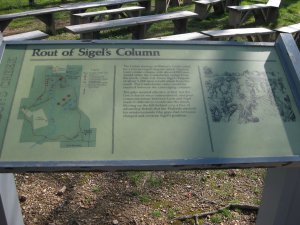
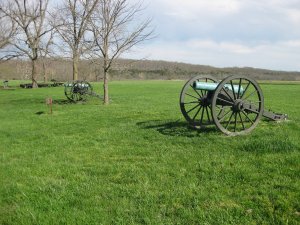

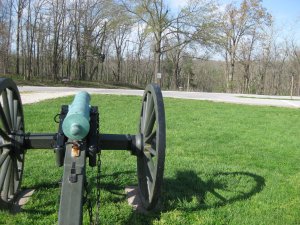
Location: The best way to experience this part of the tour is to drive to WCNB Tour Stop 5 [ Waypoint = N37 05.735 W93 24.589 ] and then proceed to the points of interest on foot. From the parking area at tour stop 5, you will see two artillery pieces, a Model 1841 6-pounder Gun (near) and a Model 1841 12-pounder Howitzer (far), off to your right (west) placed where part of Backof's Battery was deployed.
 |
 |
 |
 |
Walk across the Tour Road and down the Wire Road to Skegg's Branch. If the water in Skegg's Branch is low, you should be able to cross over the ford. If you walk north along the Wire Road and look to the east, you can see where Confederate Brigadier General Pearce's Headquarters [ Waypoint = N37 05.892 W93 24.452 ] was located. Just to the north of that location on the high ground was the location of the Fort Smith Light Battery.
Now turn around and from Skegg's Branch look back up the hill along the Wire Road towards Backof's Battery. This is where McCulloch's counterattack [ Waypoint = N37 05.805 W93 24.525 ] began. The road is so steep that you cannot see the battery. Now walk slowly back up the hill. As you walk up the hill, you can get an idea of how concealed the Confederate forces were as they approached Sigel's position.
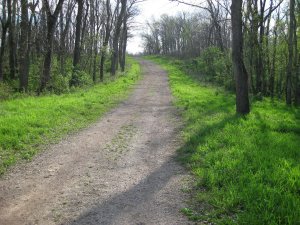 |
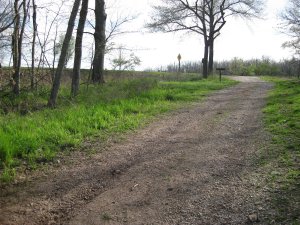 |
Description: Sigel had observed the Confederates rallying and preparing to attack him, but failed to recognize the precarious position his forces were in. He knew his brigade was outnumbered, but must have felt that the enemy's situation continued to be chaotic and confused. After the second artillery barrage had scattered the Confederates in front of him, Sigel had advanced his men to the position at which you are standing.
Under attack from two directions, Confederate General Ben McCulloch had been trying to figure out what was going on. Riding down the Wire Road, he discovered that Sigel had taken up a position across the Wire Road south of the Confederate position. Based on his observations, McCulloch felt that Sigel's position was vulnerable. Directly in front of Backof's Battery was a steep drop down to Skegg's Branch, so steep that anyone approaching from the north would not be seen until the very last minute. To prevent this, Sigel had posted skirmishers in advance of his position to warn of an enemy advance.
Confederate General McCulloch began to gather units to launch a counterattack against Sigel. He went north up the Wire Road to get the units that had fought in the Ray cornfield. After fighting the Federals in the Ray Cornfield, this regiment had been scattered by Union artillery fire. McCulloch came across units from the Third Louisiana Infantry under the command of Lt. Colonel Samuel M. Hyams. Leaving Hyams to gather up additional units and sending a message to McIntosh to bring additional support, McCulloch led two companies from the Third Louisiana down the Wire Road and across Wilson's Creek down to Skegg's Branch.
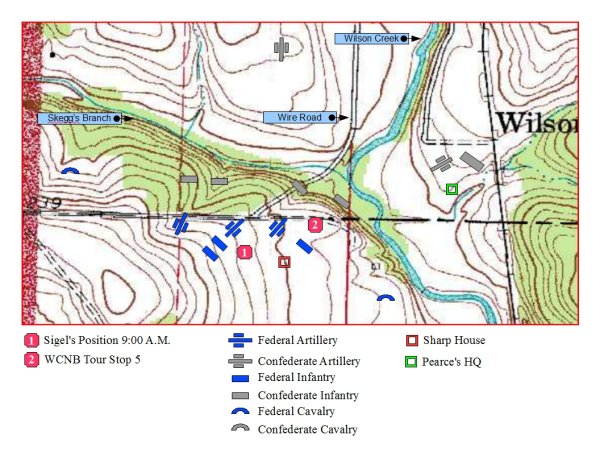
As they crossed Skegg's Branch, the skirmishers that Sigel had placed withdrew up the hill an reported that Lyon's men were coming down the Wire Road. In the meantime, additional forces under Hyam and McIntosh had arrived at Skegg's Branch. McCulloch deployed them into line of battle. Units from the Missouri State Guard had also arrived in response to Sigel's earlier attack.
Sigel was reacting to the report that Union troops from Lyon's command were approaching by issuing orders to avoid friendly fire casualties. Sigel then tried to determine the identity of the approaching forces. He sent forward Private Charles Todt from Company K in the Third Missouri Regiment. As Todt moved down the hill to identify who was approaching, he was shot and killed by the Confederates. McCulloch then ordered his forces to attack and they raced up the hill. McCulloch infantry attack was supported by artillery fire from the Fort Smith Light Battery and Bledsoe's Missouri Light Battery.
Sigel's position was quickly overrun, in part because many of the Federals still believed the advancing forces were friendlies. Even though Sigel's men outnumbered the Confederates by three to one, the Federals were routed and they fled in retreat. The Confederates were able to capture four of the artillery pieces as the men from Sigel's Brigade retreated in complete disarray.